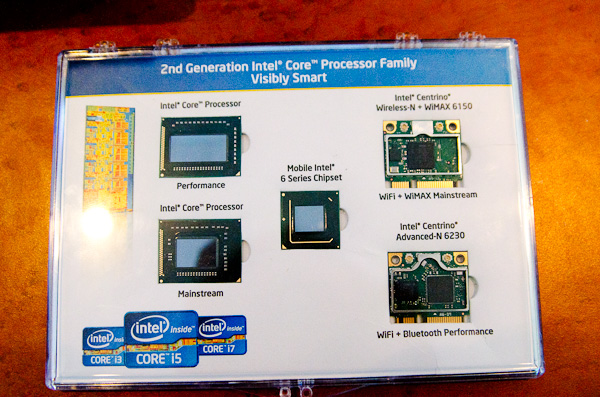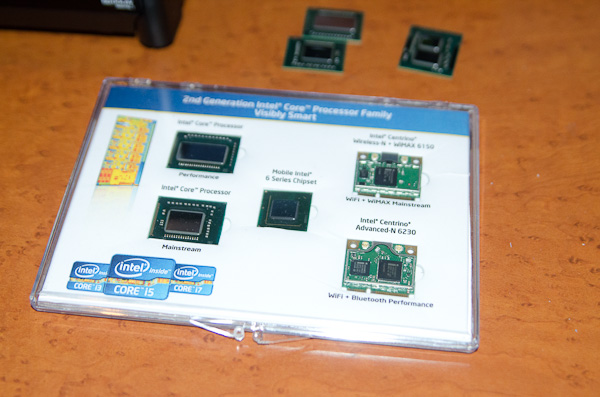Aside from a stack of Reese’s Peanut Butter Cups, I snagged something else of interest at my Intel meeting at CES 2011: a shot of some exposed Sandy Bridge processor die. As a recap SNB is available in three different physical die versions today: quad-core, dual-core with GT1 graphics and dual-core with GT2 graphics. The die sizes and transistor counts are below:
| CPU Specification Comparison | ||||||||
| CPU | Manufacturing Process | Cores | Transistor Count | Die Size | ||||
| AMD Thuban 6C | 45nm | 6 | 904M | 346mm2 | ||||
| AMD Deneb 4C | 45nm | 4 | 758M | 258mm2 | ||||
| Intel Gulftown 6C | 32nm | 6 | 1.17B | 240mm2 | ||||
| Intel Nehalem/Bloomfield 4C | 45nm | 4 | 731M | 263mm2 | ||||
| Intel Sandy Bridge 4C | 32nm | 4 | 995M | 216mm2 | ||||
| Intel Lynnfield 4C | 45nm | 4 | 774M | 296mm2 | ||||
| Intel Clarkdale 2C | 32nm | 2 | 384M | 81mm2 | ||||
| Intel Sandy Bridge 2C (GT1) | 32nm | 2 | 504M | 131mm2 | ||||
| Intel Sandy Bridge 2C (GT2) | 32nm | 2 | 624M | 149mm2 | ||||
Now for the shot:
From left to right we have a dual-core GT2 die, a quad-core die and a 32nm Arrandale die with on-package 45nm HD Graphics GPU. There’s very little difference between the dual-core GT2 die and the quad-core die - each SNB core is fairly small at 32nm.
The comparison to Arrandale is also interesting as it makes dual-core SNB look pretty sensible. But keep in mind that we don’t know the full cost structure for manufacturing at 45nm vs. 32nm. Newer processes tend to be more expensive initially compared to older, more mature processes.
Source: http://www.anandtech.com/show/4118/a-closer-look-at-the-sandy-bridge-die
Katie Holmes Victoria Beckham Missy Peregrym Sarah Gellman Eliza Dushku




No comments:
Post a Comment